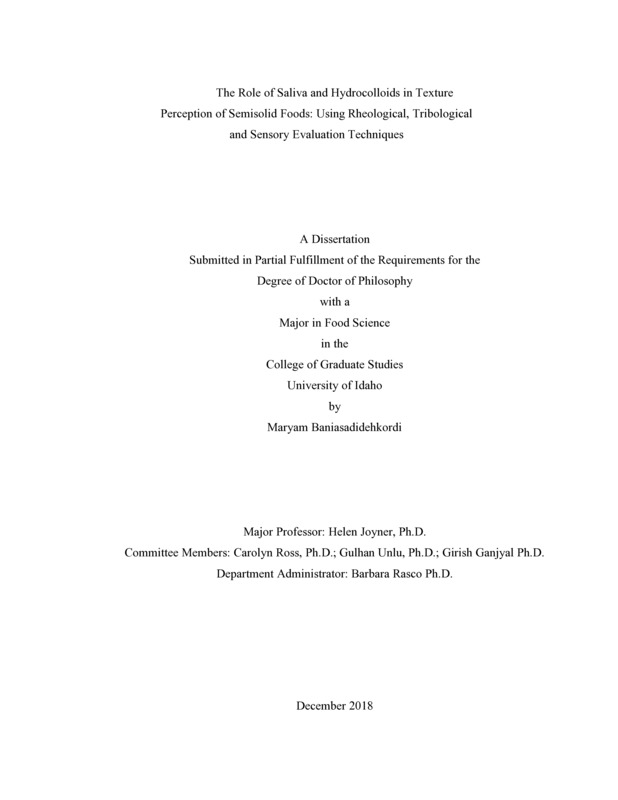The Role of Saliva and Hydrocolloids in Texture Perception of Semisolid Foods: Using Rheological, Tribological and Sensory Evaluation Techniques
Baniasadidehkordi, Maryam. (2018-12). The Role of Saliva and Hydrocolloids in Texture Perception of Semisolid Foods: Using Rheological, Tribological and Sensory Evaluation Techniques. Theses and Dissertations Collection, University of Idaho Library Digital Collections. https://www.lib.uidaho.edu/digital/etd/items/baniasadidehkordi_idaho_0089e_11504.html
- Title:
- The Role of Saliva and Hydrocolloids in Texture Perception of Semisolid Foods: Using Rheological, Tribological and Sensory Evaluation Techniques
- Author:
- Baniasadidehkordi, Maryam
- ORCID:
- https://orcid.org/0000-0003-0854-9738
- Date:
- 2018-12
- Keywords:
- Human whole saliva hydrocolloids oral processing Rheology Sensory evaluation Tribology
- Program:
- Food Science
- Subject Category:
- Food science
- Abstract:
-
The most common way to optimize the texture attributes of semisolid foods is to use hydrocolloids as texture modifiers. However, addition of hydrocolloids to a food system may cause adverse texture effects. These unpleasant effects can be avoided by selecting the right type and concentration of hydrocolloid for the food system. Rheometry and tribometry are popular techniques that can be beneficial in characterizing texture-related attributes. However, prediction of texture attributes by instrumental testing has its own restrictions, e.g. the lack of saliva effects on semisolid food. As a result, addition of saliva to semisolid foods during instrumental testing has been used for better clarification of oral texture perception. Combining different techniques for mimicking oral processing can frame a more realistic picture of how hydrocolloids and saliva application may affect texture perception of semisolid foods. Therefore, the objectives of this work were to 1) determine the structural, rheological, tribological, and sensory properties of semisolid foods that incorporated hydrocolloids as texture modifiers, 2) evaluate the effect of human whole saliva (HWS) on these properties, and 3) determine correlations among the different properties. For this project, twenty-four acid milk gels were used as a model system. Additionally, formulations for twelve yogurts were selected as a representative sample of the acid milk gel formulations. Acid milk gels and yogurts were prepared by mixing skim milk with different milkfat contents and dry powders including skim milk powder (SMP), sweet whey protein isolate (WPI), and non-based protein hydrocolloids (locust bean gum, carboxymethyl cellulose (CMC), potato starch, and corn starch). In addition to providing functional properties, SMP and WPI were also used to adjust protein and solids non-fat. For all samples, shear rate, strain, and frequency sweeps were carried out at 8˚C and 25˚C to evaluate rheological behaviors. Tribometry was also performed at 25˚C to measure frictional behaviors. All samples were tested with and without HWS (1:6 ratio of HWS: sample). Sensory evaluation was performed using descriptive analysis. Subsequently, confocal imaging was used to determine sample microstructural differences for different formulations and upon addition of water and HWS. ANOVA, principal component analysis (PCA), and partial least squares (PLS) were used to analyze the results. Overall, the viscosity, viscoelastic, frictional, microstructural, and sensory profiles of the formulations were significantly different for different formulations and with addition of HWS. Combinations of hydrocolloids in yogurts, including CMC and PS individually and all hydrocolloids together, were correlated with desirable textural attributes i.e. viscosity, firmness, smoothness, and spoon viscosity. These samples also showed negative correlations with grittiness, chalkiness, astringency, and graininess. These correlations also were found in acid milk gels made with all hydrocolloids, as well as samples including CMC individually or in combination with a gum (e.g. PS) or with WPI. Acid milk gel and yogurt formulas made with either CMC alone or with all hydrocolloids showed similar rheological, tribological, and microstructural properties. Samples with PS had the most drastic structural changes after addition of HWS. Rheological, tribological, and sensory properties showed significant correlations for multiple parameters. Mouthfeel attributes from sensory results correlated well with acid milk gel friction behaviors, viscoelastic parameters, and viscosity parameters. Undesirable sensory attributes, i.e. grittiness, graininess, chalkiness, and astringency, were positively correlated with friction coefficients within sliding speeds of 15-30 mm/s and negatively correlated with positive sensory attributes such as smoothness, firmness, and viscosity related attributes. Friction coefficient at 30 mm/s was correlated with all textural attributes except spoon lumpiness. G* was positively correlated with viscosity and friction coefficients; c was negatively correlated with friction coefficients. Thus, friction increased with increased resistance to permanent deformation and less stiff microstructure. The results of this work highlighted the beneficial role of rheological and tribological techniques in studying texture perception of semisolid foods. Therefore, they can be used to assist in design of reduced or non-fat semisolid foods with an acceptable texture to provide healthier options to meet consumer demands.
- Description:
- doctoral, Ph.D., Food Science -- University of Idaho - College of Graduate Studies, 2018-12
- Major Professor:
- Joyner, Helen
- Committee:
- Ross, Carolyn; Unlu, Gulhan; Ganjyal, Girish
- Defense Date:
- 2018-12
- Identifier:
- Baniasadidehkordi_idaho_0089E_11504
- Type:
- Text
- Format Original:
- Format:
- application/pdf
- Rights:
- In Copyright - Educational Use Permitted. For more information, please contact University of Idaho Library Special Collections and Archives Department at libspec@uidaho.edu.
- Standardized Rights:
- http://rightsstatements.org/vocab/InC-EDU/1.0/

